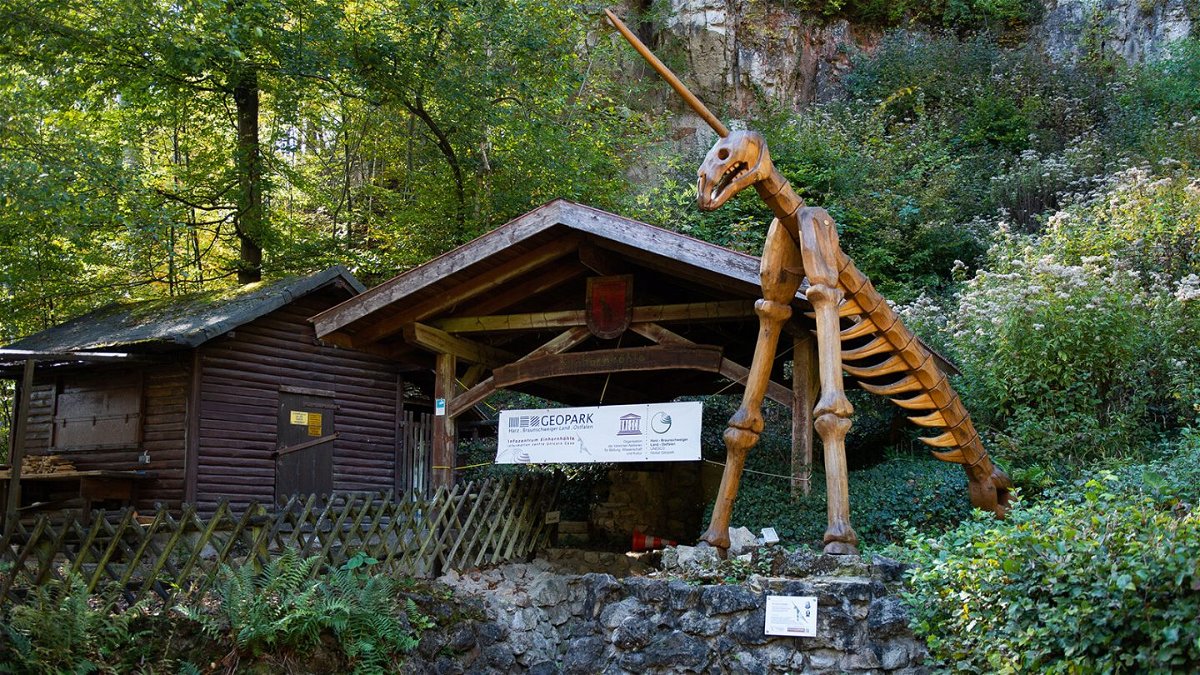What a tiny bone tells us about Neanderthal thinking

This is the public entrance to the Einhornhöhle cave
By Katie Hunt, CNN
It’s easy to accept that the world is home to many species of dolphins, cats or bears — but the idea that we once roamed the planet with other human beings is more astonishing.
We often dismiss our extinct cousins as brutish cave dwellers — and the word Neanderthal is thrown about as a dig at people who have outdated ways of thinking.
Nice try, but not quite. We are learning Neanderthals were just as innovative and sophisticated as we fancy ourselves to be — raising questions about what it means to be human.
It’s me, Katie Hunt, filling in for Ashley Strickland, in this edition of Wonder Theory.
We are family
A tiny, engraved bone is changing how we think about Neanderthals, the heavily built Stone Age hominins who disappeared about 40,000 years ago.
Found in Einhornhöhle (or Unicorn) cave in northern Germany, the decorated deer phalanx, or toe bone, features a geometric pattern. Researchers have said it’s the most definitive evidence yet that Neanderthals were capable of artistic expression — a sign of what archaeologists call complex behavior, once thought unique to Homo sapiens.
What’s less clear is how Homo neanderthalensis learned these skills. The possibility that Neanderthals were just as cognitively advanced as Homo sapiens also may have implications for why they died out.
Other worlds
The aurora borealis, or northern lights, are Earth’s greatest light show, dazzling those lucky enough to see them in the northernmost reaches of our planet.
It’s a phenomenon shared by other planets in our solar system, including the largest, Jupiter, which is bathed in spectacular color at its poles.
Characterized by massive pulsating X-ray flares, Jupiter’s northern lights were first discovered 40 years ago. Astronomers have long sought to explain the mechanism behind these auroras.
Now, an international team of scientists has announced they have solved what NASA has called “a powerful mystery.”
Consequences
Plastic waste is a visible way humans contaminate rivers and oceans, but less noticeable forms of pollution can be just as perilous for aquatic life.
Traces of illegal drugs — via sewage systems — can infiltrate waterways in urban areas. Researchers in the Czech Republic have investigated whether illicit drugs at levels found in bodies of freshwater alter fish behavior.
In the study, the scientists found brown trout living in a tank of water containing methamphetamine for a period of eight weeks sought out water containing the drug — when given a choice — for four days after being transferred to meth-free water.
This behavior suggested the fish were experiencing withdrawal because they sought out the drug when it became available, according to researchers.
Defying gravity
A spacewalk is the most dangerous job in space. Imagine trying to focus on a memorized set of tasks while stepping out of an airlock and wearing a 300-pound spacesuit — with the glow of planet Earth and the sun and the dark void of the universe all around you.
Two Chinese astronauts have completed the country’s second-ever spacewalk and the first from the core module of China’s new space station. The mission marked a huge achievement for the country, which has been excluded from the International Space Station.
Back on Earth, though, a violent attack on two Chinese space scientists has drawn the wrong kind of attention to China’s celestial ambitions.
Sign up for Meanwhile in China, CNN’s three-times-a-week newsletter on the latest news you need to know about China’s rise and analysis on what it means for the world.
Climate changed
Scientists have pored over more than 300 fossils belonging to different members of the Homo genus, or the human family tree — including us, Homo sapiens — and reconstructed the Earth’s climate to see what conditions were like when these different species of human lived.
The researchers found that climate — particularly temperature — has been the main driver of changes in body size for the past million years.
Colder, harsher climates were linked to larger bodies, such as those of well-built Homo neanderthalensis, while warmer climates were linked to smaller bodies, the scientists found.
For now, the team said, it’s unlikely that the current, human-induced climate crisis will dramatically impact our body sizes.
The wonder
Here are some more mind-blowing reads.
— Holy cow! Scientists in Austria may have found an unlikely solution to the problem of plastic pollution.
— Check out eight pivotal moments from NASA’s Space Shuttle Program.
— Virgin Group founder Richard Branson will take a rocket-powered space plane to the edge of space this weekend. If all goes according to plan, Branson will be the first billionaire to travel to space on a vehicle he helped fund, beating fellow space baron Jeff Bezos by nine days.
— In fossilized dinosaur poop, researchers have found a creature unknown to science. And it was preserved in three dimensions.
Like what you’ve read? Oh, but there’s more. Sign up here to receive in your inbox the next edition of Wonder Theory, brought to you by CNN Space and Science writer Ashley Strickland, who finds wonder in planets beyond our solar system and discoveries from the ancient world.
The-CNN-Wire
™ & © 2021 Cable News Network, Inc., a WarnerMedia Company. All rights reserved.

